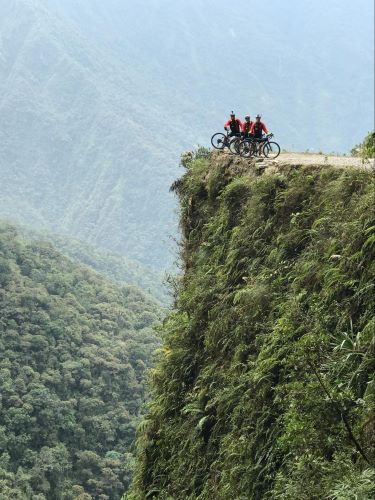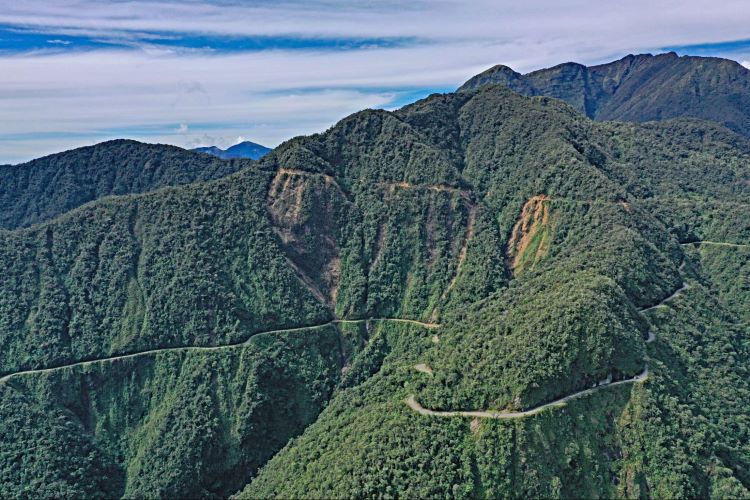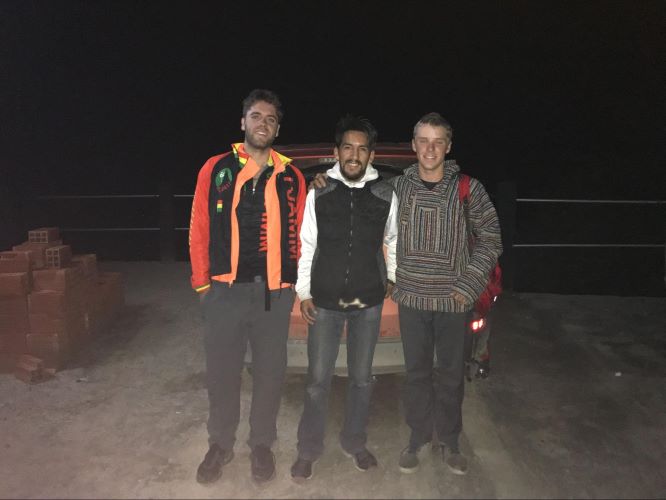Bolivia's Death Road, the World's Most Epic Bike Climb
-
Death Road in Bolivia stands as a giant among giants. It is not the most difficult climb in the world, but -for my money- it is one of the toughest. There are just so many variables to contend with and danger is -literally- around every bend. A total of 11,624 feet is gained over 38.7 miles for a summit elevation of 15,187 feet. But wait - there's more... the first 25.5 miles are rugged, mostly unmaintained, gravel with a sheer drop-off and no guardrail (hence the road's name) with the final paved miles being a busy highway with little shoulder. The Death Road stands as the most epic and unforgettable climb I have ever summited.
In the fall of 2017, myself, John Johnson, and Will Plaugher trekked to Bolivia to see if the Death Road was all it was cracked up to be. I had seen the road before in an episode of Top Gear, but assumed that the route had been dramatized for television. Surely it couldn't be that dangerous, right?
Our journey to South America had gotten off to a, typically, PJAMM chaotic start. We'd realized a week before leaving California that Bolivia had special visa requirements and our entry into the country remained uncertain despite our frantic efforts to obtain Bolivia's special visa prior to takeoff. Having slept in an oxygen-deprivation tent for months before the trip, I was especially apprehensive during the flight south. We had a short layover in Panama, then crossed our fingers for the whole flight to Bolivia. None of us had any idea what to expect at Bolivia's immigration control checkpoint. What if we were denied entry and forced to return to California as complete failures? Failures! The stakes couldn't have been any higher.
Fortunately, we sailed through the immigration checkpoint at the La Paz airport without any major issues. Of course, we ended up paying a few hundred dollars in bribe money, but this would become a norm of South/Central America that I'd grow quite fond of. In some sense, there are no real rules in those parts of the world, if you have enough bribe money.
After landing in La Paz, we drove our rental Toyota Hilux to our Airbnb in a quiet corner of the city. I chose the top bunk bed in our cozy room, in an effort to gain an acclimatization edge on my comrades. Though I was only sleeping a few feet above John and Will, I imagined that the extra feet above sea level would give me the needed strength for the monumental task to come. And, (most importantly) my extra feet of acclimatization would dish out a mortal blow to my cycling friends, which is always the most important consideration when traveling with cyclists.
We spent a day driving the spider web of roads that entangle the high mountain capital city of La Paz, which holds the record of being the 'highest capital city in the world' at 11,983 feet - though folks in my new home of Arcata, CA in the Emerald Triangle may take issue with that distinction...
We paid a small bribe for an unclear reason to a cop on foot near the town center in La paz and struggled greatly to find any of the provisions we needed for our epic journey ahead. We learned quickly just how different life operates in Bolivia and I was eating it all up. I didn't just feel like I was in a different country, I felt like I was on a different planet in La Paz. I was 20 years old at the time and seeing a new world for the first time. My excitement for the climb up the Death Road the following day could not have been higher.
The Death Road begins in a small village called Yolosa. There's a cafe or two, a place to grab a bite to eat, and not much else. We'd hired a local named Diego to drive our Toyota Hilux behind us for support. As it turned out, Diego spoke no English. Myself and John spoke only elementary level Spanish, but Will is fluent and translated between the four of us on the wild drive from La Paz to Yolosa.

On the morning of September, 17th 2017, we said our goodbyes in Yolosa - it would be every man for himself to the summit. In the opening miles of the Death Road climb, I was flying. A combination of adrenaline, excitement, and bottled-up energy made me forgo any sane pacing techniques and instead attack the climb at full power, from the gun. My heart rate was pegged around 190 bpm as I passed the homesteads that line the lower parts of the road.
Passed the homesteads, after climbing a few thousand feet, the reason behind Death Road's iconic name became blatantly clear. The road itself is narrow, often muddy, with sheer drop-offs to certain death for nearly the entirety of the North Yungas Road (Death Road) section of the climb up the summit at La Cumbre. On the Death Road, it is customary to drive (and ride) on the left side of the road, meaning uphill travels have the luxury of hugging the innermost section of the road. I struggled to remember this and came around a blind corner near mile 18 to meet a car coming straight for me. Thankfully, the local driver was on high alert and had good working brakes.
It's impossible to encapsulate just how staggering the climb up the Death Road is. It is mile after mile of sheer cliffs, and jungle views, marked by a concerning number of crosses denoting places where people had perished. This, all in the thin air of Bolivia combined with my inability to pace myself meant that by the turn onto Ruta Nacional 3 at mile 25.5, I was completely gassed.

On the paved highway, the weather began to turn on me. I entered a thick cloud line and the temps plummeted to below freezing. As Ruta Nacional 3 is the main vein to La Paz from the Coroico area, one can expect a steady flow of traffic. Unfortunately, there is not much of a shoulder on the highway. I had a number of cars pass me with mere inches to spare, but it was almost certainly not done intentionally. Near the summit, visibility was reduced to a few bike lengths. On top of bonking (a specialty of mine) and running out of water, I had a splitting headache - usually the first sign of altitude sickness. Despite my state, I reached the summit at La Cumbre after about 6 hours of climbing. The winds were absolutely howling at the summit and snow was blowing sideways onto my face. The plan was for our faithful Diego to meet us at the summit so that we could shelter in the Hilux and avoid the dangerous ride down the highway. When I got to the summit though, Diego was nowhere to be found. I took a few photos and considered my options. As I had gotten really sweaty on the long climb up, my clothes were soaked and caused me to shake uncontrollably once I stopped pedaling at the summit. I couldn't feel my fingers and decided after only about ten minutes at the summit that I had to begin riding down immediately. If I waited any longer, I knew my body wouldn't be capable of operating the bike at all. Mercifully, after only riding a few miles down the mountain, I saw a Toyota Hilux parked in a dirt pullout. Diego! It turned out that Diego had fallen asleep and seemed very surprised and confused to see me in such a bad state. Thankfully, I knew how to say, "I need warmth," in Spanish and Diego turned the heater on full blast for me.
The communication barriers between Diego and I proved a very big issue, as I could not get the message across that we need to leave the dirt pullout and go check on my friends, John and Will. No matter how I mimed, played charades, and spoke Spanglish - Diego couldn't seem to get the message. It seemed that he thought he was doing exactly what he'd been instructed to and wasn't going to take orders from me.
Then, out of the fog, I saw my spandex-clad comrades jump out of a beat-up old, red Toyota Corolla. They were sprinting towards the Hilux with concern written plainly on their faces. They'd assumed that I had been kidnapped and had ditched their bikes in an effort to hitchhike to La Paz to find me. Tensions were a bit high between the four of us, but -of course- it all melted away once we ate a nice pasta dinner back at the hotel.

Diego and me at the end of our journey.

